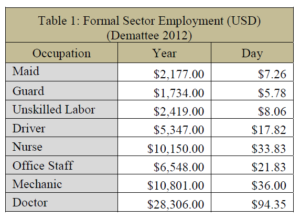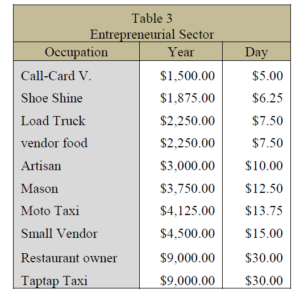Fallacies
In understanding a “fair wage” a couple fallacies should be recognized. First, official unemployment rates for Haiti vary between 70 to 80 percent. Similarly, organizations such as the World Bank have estimated that over 50% of the Haitian population lives on less than $1 per day and as much as 80% lives on less than $2 per day. The problem with these figures is that most of the eighty percent of the “unemployed” Haitian population is hard at work in a vibrant informal sector and the thriving internal domestic marketing and service economy. Moreover, although by international standards they earn extremely low wages, most are members of households that reduce the cost of living by pooling financial and labor resources. Households often also function as productive enterprises around which labor is organized and products processed and marketed.
Informal Economy
Haitians work in the informal sector as night watchman, yardman, maid, cook, nanny, teacher, policeman, guard, porter, butcher, baker, tailor, basket maker, rope weavers, carpenter. mason, iron smith, mechanic, electrician, plumber, radio technician, typesetter, copier, and painter. They make nets, weirs, boats, beds, latrines, roofs. They work in domestic healthcare industry as nurses, doctors, herbal and spiritual healers and priests. They work as sea captains, mariners, and boatswain in the thriving mostly informal domestic shipping sector and drivers and truck loaders and fee collectors on the thousands trucks that carry goods throughout Haiti. Tens of thousands work as drivers on the moto-taxis that fill the streets, back roads and paths of the country. They distill alcohol and make comestibles from small candies to prepared nuts, fish, fried snacks, and meals sold in street restaurants. And they work as vendors selling everything from the ubiquitous corner stall peddling a single cigarette and shot of rum to telephone recharge cards to hair ties to small bags of water to cures for aids and cancer and unrequited love and bad luck or dozens of different lottery tickets. More than 50% of them farm and/or fish. And almost every one of them is engaged not in a single one of these occupations, but several.
Gender
Many of the occupations mentioned above are for men, but some are un-expectantly female–such as butchers and fish processers. Women will perform most farming tasks. Women are masseuses and midwives. They exclusively monopolize the ownership and management of popular restaurants. Although men make some comestibles, most production of candies and other treats are female enterprises. But more than anything else, women completely dominate the movement and redistribution of domestic produce. They are thought of as the owners of the produce from their husband’s gardens. They harvest and sell the produce and with the money invest in the purchase and resale of the produce that other women harvest and they so dominate this sector of the economy–trade in domestic produce– that middle aged woman are often equal or more economically powerful than their husbands.
For those men and women who can’t find a place men pursue income in seasonal farming, fishing, transport, and construction sectors and they migrate to the Bahamas, the Dominican Republic, Canada and the United States where they engage in any number of occupations, not least of all the sex industry and narco-trafficking. Women migrate to the same places where they work in factories or as cooks, nannies, maids, prostitutes or masseuses or bar girls. Haitian women also make a strong showing in the neighboring Dominican Republic’s international marriage market where each year thousands of them marry foreigners and fly off to join the North American and European middle and upper classes.
Wages
Real Wages
Most of these occupations described above are petty income opportunities, many of them, such as midwfiery or rural construction are not fulltime but rather intermittent opportunities. Others such as selling candies or weaving are ongoing activities that complement other endeavors and may yield as little as US $1 per day. For fulltime occupations the minimum wage is 200 gourdes (~ $5) for most formal sector workers and 125 gourdes (~ $3.00) for apparel workers in trade free zones. Farmers throughout the country consistently pay their neighbors 150 gourdes per day ($3.00)–that is 25 gourdes more than minimum wage– for what they call a jouné, 6 hours of intense agricultural labor. If they provide a meal they pay 100 gourdes ($2.50). On a higher level It is noteworthy that skilled artisans earn about US $10 per day.



Living Wage
Organizations such as Solidarity Center have calculated monthly living wage for a Port-au-Prince apparel worker and three dependents at $29 US. And it is a reasonable estimate. It is calculated based on the local price of a “food basket,” rent, and prevailing costs of education, transportation, and healthcare. But what is a “fair” wage should not hinge only on what would make the producer’s life comfortable. We must be realistic. We cannot reasonably expect wholesalers, retailers and consumers to pay Haitian workers 15 times what a competitor in China is making. Nor can we expect them to pay semi-literate apparel workers or artisans wages equivalent to what Haitian bankers and medical doctors earn or, for that matter, three times the salaries of their supervisors.
Household and How people are able to Survive on Low Wages
The key to understanding how people survive in Haiti on below “living wage” salaries is the role of the household as a social security mechanism and productive unit. Households pool labor and resources to lower individual costs of living and to enable members to survive difficult times. Even very young members of the household may contribute to livelihood security by fetching fire wood and water, running errands, selling goods by the street or out of the home, washing clothes, and preparing meals. Perhaps more importantly than anything else in understanding the household as the basis for livelihood strategies and the role that children play is that for both urban and rural areas children stay home and perform basic domestic tasks and care for younger siblings thereby freeing their old sisters, cousins, aunts and mothers to engage in itinerate trade and go to urban areas to work as domestics.
Summary and Conclusion
In summary, the “fair wage” recommended at the beginning of this report is based on competitive wage opportunities and the interdependence of household members on one another and the productive character of household. The wages are low and below what we might determine to be a “living wage. But people are able to survive on low wages because they are part of household livelihood strategies that draw income from a variety of sources. Moreover, the competitive international wage market for labor means that every dollar more paid to Haitian producers lowers the probability that that Haitians can participate in the manufacturing sector. It would be good if Haitians could earn a higher income. But it would be unfair to eliminate them based on high wage demands, especially when the prevailing wages inside Haiti are even less.
**********








